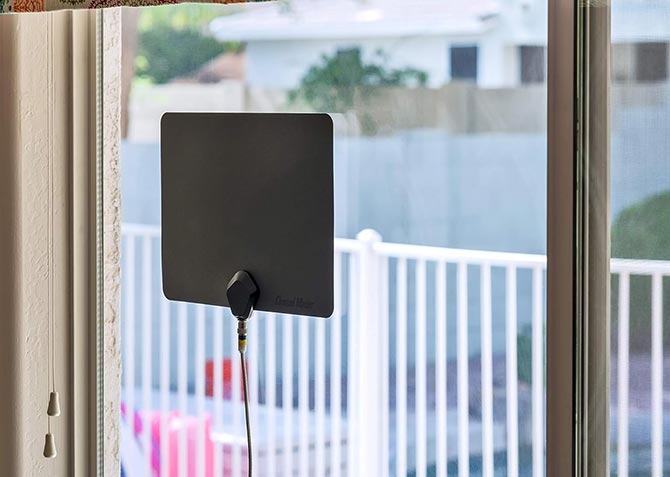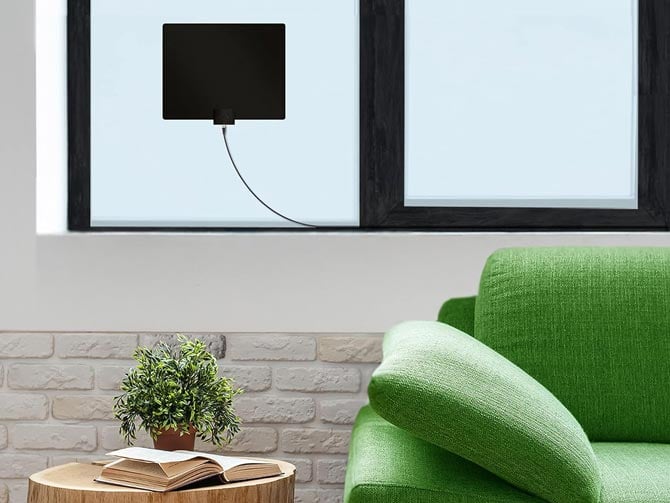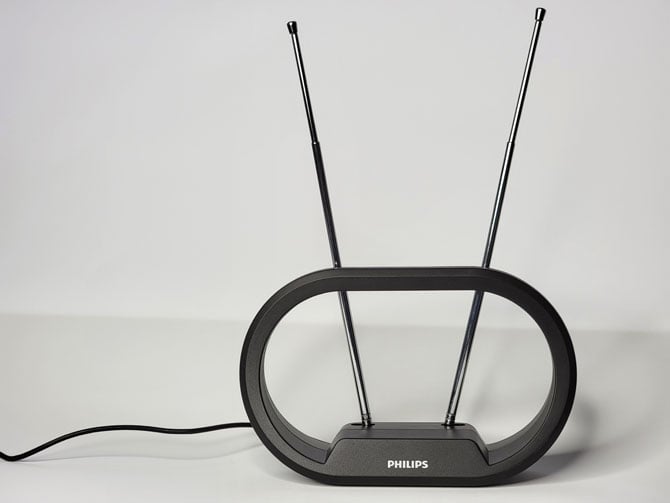We may earn commissions when you buy from links on our site. Why you can trust us.
The Best Indoor TV Antennas
Why buy an indoor TV antenna
A Cord-Cutting Essential
If you’re tired of paying for live TV or just want a backup option that doesn’t rely on the internet, an indoor HDTV antenna is a smart investment. With the right antenna, you can access major network channels like ABC, CBS, NBC, FOX, and PBS, along with various local stations, all without a monthly subscription. Depending on where you live, that could mean anywhere from 20 to over 100 channels, all in crisp HD or even 4K resolution. And since over-the-air (OTA) broadcasts aren’t compressed like cable or streaming services, the picture quality is often better than what you’d get from Hulu + Live TV, YouTube TV, or satellite.
However, not all antennas are created equal. Outdoor antennas, especially rooftop models, typically provide the best reception, but they aren’t always practical due to installation challenges or homeowner restrictions. Indoor antennas, on the other hand, offer a hassle-free solution that doesn’t require climbing onto your roof or running long cables. While they may not always match the performance of an outdoor setup, many modern indoor antennas are designed to pull in signals with impressive clarity, making them a great choice for apartments, condos, and homes where an outdoor antenna isn’t an option.
4K OTA is Coming: NextGen TV
NextGen TV, also known as ATSC 3.0, is the latest advancement in over-the-air (OTA) broadcasting, promising improved picture and audio quality, interactive features, and better signal reception. While 4K UHD broadcasts are possible with NextGen TV, most channels currently aren’t actually broadcasting in full 4K HDR. Instead, many stations still deliver content in upscaled 1080p or 1080i. However, as more networks adopt the new standard, the potential for true 4K UHD over the air continues to grow.
Your current indoor TV antenna will still work with NextGen TV signals. If your local stations have transitioned to ATSC 3.0, you can take advantage of benefits like higher-quality audio with Dolby Atmos support, enhanced signal stability, and interactive content features, all without needing a cable or streaming subscription. However, to actually receive and decode these NextGen TV signals, you’ll need either a TV with built-in ATSC 3.0 support or an external tuner.
NextGen TV is already available in many major cities across the U.S., and its rollout is expected to continue expanding in the coming years. While we’re not yet at the point where 4K OTA broadcasts are standard, this new technology lays the groundwork for a future where free, over-the-air television rivals (or even surpasses) the quality of cable and streaming services.
Works with OTA DVRs and USB tuners, and even Smartphones
Using an antenna does not mean you are beholden to the broadcast schedule. DVRs, like the ZapperBox M1 ATCO 3.0 Tuner ($274.95) are. These devices have built-in tuners – so you can even use them to watch TV on a PC monitor or using a projector – and have the flexibility to record and watch shows at your leisure. There are even adapters you can use to watch OTA TV on smartphones and tablets.
If you are into sports or following the news, you can employ a USB DVR with multiple tuners (only one antenna is needed) and watch various live TV channels simultaneously, or record one or more channels while you watch another. It's old-school binge-watching sorcery, with the added benefit that with DVR content you can fast-forward through commercials.
Backup Plan for Cable Subscribers
Even if you are not a cord-cutter, the low cost of a TV antenna makes it an easy-to-justify accessory for your TV. If, for example, you experienced a problem with your cable service halfway through the Super Bowl, you'd have the option of switching to the antenna. The same goes for natural disasters – you might lose your cable service and fast Internet, but if you have an antenna, then you'd still have access to news from your TV.
Read more: Streaming in 2025 Isn’t the Bargain It Used to Be
Also Works with FM Radio
If you have an audio system with an FM tuner and a coaxial input – many AV receivers offer this option – you can use a TV antenna as an FM antenna. Sharing an indoor antenna with a TV is impractical, so if you want to receive both FM radio and OTA TV, you’ll want to buy a separate antenna for each device, rather than trying to rig up a signal splitter.
What to look for in an indoor HDTV antenna
Various form factors
Indoor antennas come in various styles, some of which are easy to hide, and others allow for easy placement on a flat surface. This decision is partly driven by where your TV is located, with flat antennas being ideal for wall-mounted TVs, while freestanding antennas are handy when you have a TV on a table, stand, or credenza.
The size and shape of an antenna are closely related to its passive performance (that’s how much signal it pulls in without amplification). Typically, the larger the antenna, the stronger the passive signal and, therefore, the longer the range.
Since the form factor affects placement options, it also affects reception inside homes. Ideally, an indoor antenna should be located near a window for the best reception, but if that’s not feasible, experimenting with the available placement options within a room may yield more channels, and it only takes a few extra minutes to run the channel scan again and compare.
Range: Amplified or Passive
Aside from the form factor, one of the main differences between indoor antennas is whether they are amplified or unamplified. And this, in turn, is one of the main differentiators between indoor antennas in terms of their range.
While indoor antennas are sold with an advertised range, due to various factors that include topography, weather, and the walls of your house, those range estimates are practically meaningless. But they do loosely correlate to increased capability, especially within the product line of a single company.
Amplified TV antennas boost the passive signal. The amplification requires external power, which makes for a slightly more complex install. Notably, you can add an amplifier (aka signal booster) to any passive antenna, but the combined cost tends to be higher than simply buying an amplified antenna.
The usefulness of an antenna amplifier is highly circumstantial. Indeed, our hands-on experience calls into question the value of amplification. Why? One hypothesis is that in areas where reception is strong, an amplifier might actually over-amplify the overall signal coming from the antenna (which contains all the channels). The result is worse reception, not better, because the highly amplified strong channels cause the weak ones to get lost. This is supported by anecdote as we’re not the only ones to encounter this phenomenon.
While we saw no benefit from amplification, someone who lives in an area with overall poor reception very well might. Channel count is one thing and signal stability is another: An amplifier can sometimes help turn an intermittent weak signal into an uninterrupted one. Ultimately, our reception results with and without amplification are specific to our test site.
Another use for an antenna amp is for extra-long coaxial cable connections; for example, if the TV is in a basement and you have the antenna located on an upper floor. The extra gain from the amp will help ensure the signal makes it to the Tuner.
Features
Adjustability
The length of the connecting coaxial cable is a crucial consideration. The longer the cable length, the more flexibility you have in terms of placement. Some antennas allow you to use your own coaxial cable so that you can have a custom length. Others require the use of an extension cable if you need to go beyond the size of the provided cable.
If you are buying a flat antenna for a wall-mount application, you'll want to ensure the cable is long enough for your particular application. Mounting the antenna near (or directly on) a window is a popular tactic to maximize reception.
Look for amplified antennas with USB power instead of a proprietary wall-wart, which allows you to use a USB port on the TV itself for power. Not all USB ports provide power, so check your TV user guide.
Suppose you use an antenna with a portable device, for example, a laptop or a tablet with a tuner/adapter of some sort. In that case, you'll want to look at compact freestanding indoor antennas that are easy to carry and can sit on a tabletop.
Aesthetics
The type of antenna largely determines the appearance of that antenna. And unless you are seeking a retro look, likely the last thing you want is an old-school rabbit ears antenna (still, we did test a pair).
One of the most common indoor antennas is the flat design, which pretty much looks like what it is: a flexible sheet of plastic. Sandwiched inside the plastic is the actual antenna, which is made of thin, flat metal. Often, these antennas are white on one side and black on the other to better match the color of the walls, and are paintable. The flat antennas in this roundup are all paintable.
Freestanding antennas come in a variety of shapes and sizes. Some look a bit like Wi-Fi routers with lots of antennas sticking out, others are minimalist single-antenna designs, and you'll find flat antennas repackaged for freestanding use with varying degrees of visual appeal.
Aesthetics should only be part of the equation when shopping for an indoor antenna; after all, an antenna is useless if it does not receive the channels you want to watch. This is why buying an antenna with a good range is a high priority. But there's a good chance an indoor antenna will be visible (unless you are lucky enough to get great reception with an antenna hidden behind the TV). Therefore, you don't want to discount appearance altogether.
Read more: How to Hide Your TV Cords
Choosing the Contenders
Our final testing list results from research into ratings and reviews of indoor TV antennas, combined with hands-on experience. Because antenna performance is closely tied to the specific installation, this is a product category where aggregated anecdotal user experience is a valid measure of real-world performance, perhaps as much as a lab test.
To create a list, we browsed the existing recommendation articles found on various websites, and we perused ratings and reviews for indoor TV antennas located on Amazon.com.
Best Indoor TV Antennas

Best Non-Amplified Antenna: Channel Master FLATenna
The Channel Master FLATenna proves that great performance doesn’t have to come at a high price. This ultra-thin, reversible black-and-white indoor antenna is designed to pull in free over-the-air HD channels like ABC, CBS, FOX, NBC, PBS, Univision, and more, without a subscription.
With a realistic 35-mile reception range, the FLATenna is a great pick for urban and suburban areas, where obstructions like buildings and trees can impact the signal strength. It doesn’t require an amplifier, making setup simple and interference-free. The included 12-foot professional-grade coaxial cable provides extra flexibility for placement, whether mounted on a wall, stuck to a window, or laid flat.
While it lacks frills like built-in amplification, the FLATenna receives top marks from Wirecutter, Tom’s Guide, CNET, and consumers, making it a solid pick for anyone looking for a no-fuss, budget-friendly way to cut the cord and enjoy high-quality local broadcasts.
Price: $27.99, check price on Amazon

Mohu Leaf 50
The Mohu Leaf 50 is an amplified version of the previous Mohu Leaf 30 (a previous Techlicious selection for best indoor TV antenna), and a touch more expensive. It’s a top choice for cord-cutters looking for strong indoor reception, thanks to its 50-mile range and included amplifier. It can easily pick up local HD channels like ABC, CBS, FOX, NBC, and PBS, even in areas with moderate signal interference.
This paper-thin antenna has a reversible black-and-white design that blends easily into most home setups. It comes with a 16-foot detachable coaxial cable, so you can move it around relatively easily for the best reception. The USB-powered amplifier helps boost weaker signals, making it a great option for those who live farther from broadcast towers.
If you’re looking for a powerful yet discreet antenna that maximizes your free TV options, the Mohu Leaf 50 is a reliable option, despite it being a bit bulkier than the Mohu Leaf 30.
Price: $59.99, check price on Amazon

Philips HD Loop TV Antenna
This is a freestanding, passive "rabbit ears" style antenna. Philips claims a 30-mile range. Very inexpensive (the most affordable of this roundup), but the supplied cable is very short, just 4 feet, preventing any install option other than right next to the display.
This antenna was purchased precisely because it is the least expensive option. We wanted to establish a baseline for entry-level indoor antennas (and we like the look of the old-school collapsing rabbit ears).
It turns out that old-fashioned looks and a low price can be deceiving. This Philips is an excellent-performing antenna. If all you care about is good reception and want to spend the least you can on an antenna, this is a great choice. Its performance is quite profound, but maybe it should come as no surprise that an old-school antenna design works so well since TVs were once totally dependent on OTA reception.
Price: $17.99, Check price on Amazon
Conclusion
Our hands-on testing has taught us that advertised range and specifications are nearly meaningless when it comes to antennas. We’ve also learned that an amplified antenna is not necessarily better than a passive one; it depends on where you live.
The Top Pick for the best non-amplified indoor TV antennas is the Channel Master FLATenna ($35.00). Stretching over 13 inches wide, it’s not the most discreet of antennas, but it does boast solid reception for users in urban and suburban areas. The reversible black/white design makes it a good choice if you’re worried about aesthetics, and the included 12-foot cable allows for flexible placement.
The Mohu Leaf 50 ($59.99) is our pick for the best amplified indoor TV antenna, offering greater range if you live farther away from a broadcast tower and sporting a similar reversible black/white design as the Channel Master FLATenna. It’s more expensive than our top pick, but it’s definitely worth the investment if you need the 50-mile range.
You absolutely cannot judge an antenna by looks or by price. The Philips Modern Loop ($17.99) finished in fourth place in our previous testing, but it’s dirt cheap, selling for around 18 bucks. If you like their old-school look, then you probably don't need anything more to add OTA TV to your entertainment portfolio.
Updated on 4/7/2025 with new picks and current information on over-the-air broadcasting
[Image credit: Channel Master, Mohu, Mark Henninger/Techlicious]
Discussion 
We cut the cord and love it (saving $280/mo). Big drawback is how do we get sports?
Hulu (ESPN+) has a limited amount of hockey, soccer, college sports (none of the SEC or Big 10) and no professional football.
Any suggestions?
Sling TV provides some live linking. I use it with a Tivo Stream, a small dongle you can buy for under $50. However I did end up buying another service for the baseball playoffs. Now if I figure out what it was I may terminate it, as I’m not a big sports buff. There was a nonprofit that streamed live TV and requested a $5/month donation, but it seems to have disappeared.
My neighbor joked that my antenna can serve as a lightning rod.
There’s no one good solution for sports. It really depends on the teams and sports you follow. In general, you can usually find at least some games for free.
For professional football:
Thursday games: Fox, Amazon Prime video and NFL Network
Sunday Nights: NBC Sports
Monday Nights: ESPN (included in Sling Orange, Hulu + Live TV, YouTube TV, fuboTV)
You can also stream them for free on the Yahoo! Sports App and plug your phone into your TV’s HDMI port. (check out our instructions here: https://www.techlicious.com/tip/how-to-connect-your-phone-to-your-tv/)
For Big 10 games:
The Big 10 channel is included in Fubo TV, Hulu + Live TV and YouTube TV.
For NHL
NHL games will be streamed on ESPN+ ($6.99/month)
If you have a specific sport/league, let me know. I’m working on a streaming services story right now and am in the research phase.
Because of the curvature of the earth and the way TV signals are broadcast, 70 to 80 miles is about the limit for OTAs. Any antenna that says they have a 150 - 250 mile range is telling a fib. Where you locate the antenna is critical as well. Terrain matters. Good luck. Finding the best place to put your indoor antenna and fine tuning it is time consuming but can be worth it in the end. Be patient. You’ve got this.

















From Tim Morgan on November 03, 2021 :: 7:03 pm
I live in an out SF Bay Area suburb. After a lot of research, I pick an outdoor Mohu antenna about 12 up from the top of a steep hill behind my pool. Line of sight reception is essentially impossible, so that an omnidirectional antenna was recommended. I’m on my third brand of amplifier, and mostly get excellent reception, though the default channel guide lists several times as many channels as can be watched.
I tried an indoor antenna, though this was several years ago, and got next to nothing. It would be worth doing a follow up article on who ought to look to that option.
Reply